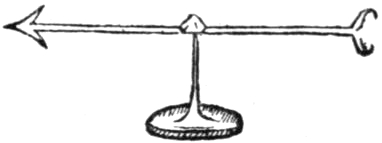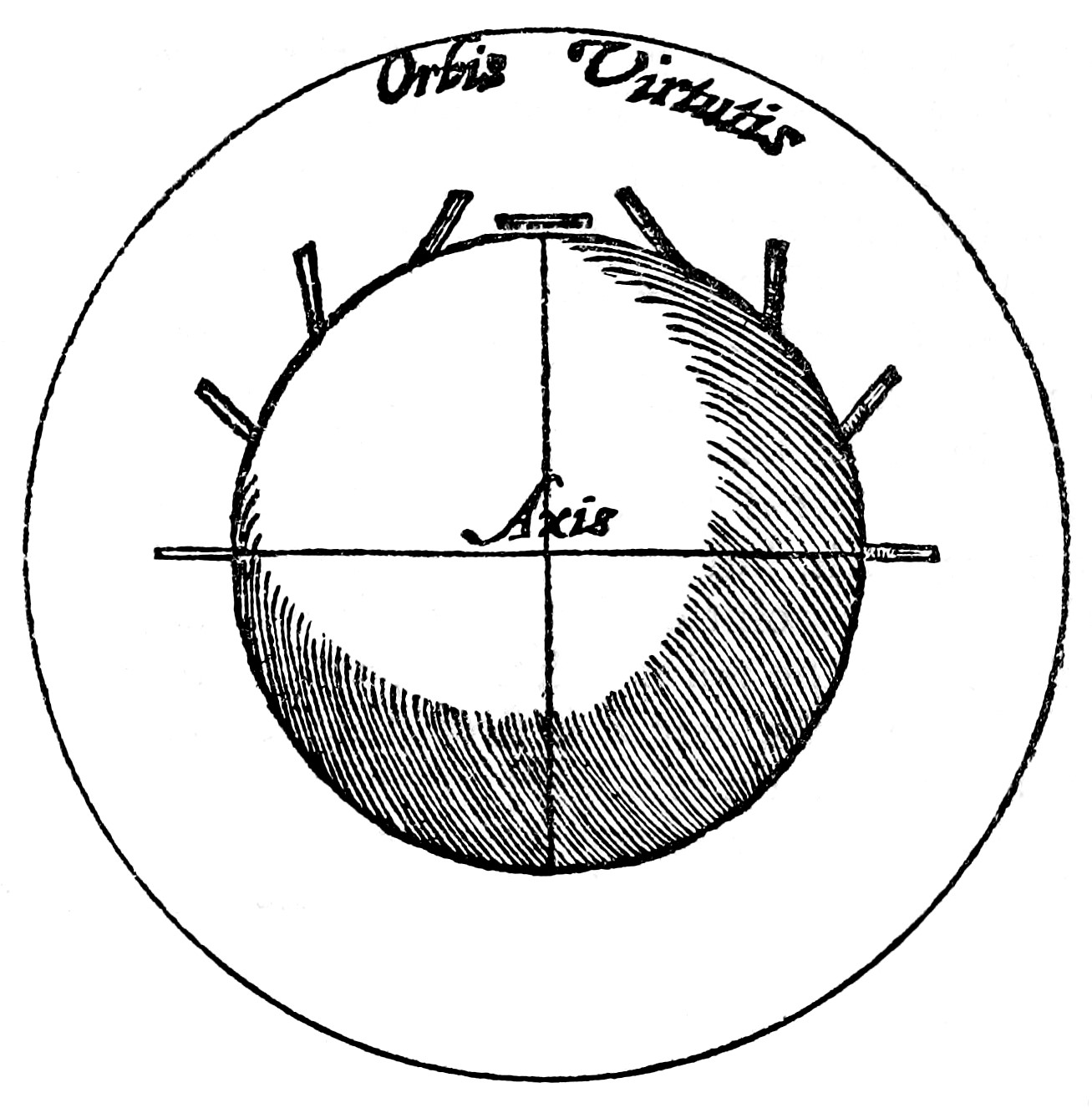De Magnete on:
[Wikipedia]
[Google]
[Amazon]
''De Magnete, Magneticisque Corporibus, et de Magno Magnete Tellure'' (''On the Magnet and Magnetic Bodies, and on That Great Magnet the Earth'') is a scientific work published in 1600 by the English physician and scientist William Gilbert. A highly influential and successful book, it exerted an immediate influence on many contemporary writers, including
 Distinction between electricity and magnetism. An amber stick when rubbed affects a rotating needle made of any type of metal (a versorium) and attracts paper, leaves and even water. But electricity is different from heat and to magnetism which only attracts iron-bearing materials (he calls it coition). He shows the effects of cutting a spherical lodestone (which he calls a ''
Distinction between electricity and magnetism. An amber stick when rubbed affects a rotating needle made of any type of metal (a versorium) and attracts paper, leaves and even water. But electricity is different from heat and to magnetism which only attracts iron-bearing materials (he calls it coition). He shows the effects of cutting a spherical lodestone (which he calls a ''
 The Earth's normal magnetism. He proposes (incorrectly) that the angle of the
The Earth's normal magnetism. He proposes (incorrectly) that the angle of the

Guilielmi Gilberti Colcestrensis
From the Collections at the Library of Congress.
the 1900 English edition printed by Chiswick Press at
Francis Godwin
Francis Godwin (1562–1633) was an English historian, science fiction author, divine, Bishop of Llandaff and of Hereford.
Life
He was the son of Thomas Godwin, Bishop of Bath and Wells, born at Hannington, Northamptonshire. He was the great ...
and Mark Ridley Mark Ridley may refer to:
* Mark Ridley (physician) (1560–1624), English physician and mathematician
* Mark Ridley (zoologist) (born 1956), English zoologist
See also
* Mark Ridley-Thomas
Mark Ridley-Thomas is an American politician. He prev ...
.
Contents
In ''De Magnete'', Gilbert described many of his experiments with his model Earth called the ''terrella
A terrella (Latin for "little earth") is a small magnetised model ball representing the Earth, that is thought to have been invented by the English physician William Gilbert while investigating magnetism, and further developed 300 years later b ...
''. Gilbert made the claim that gravity was due to the same force and he believed that this held the Moon in orbit around the Earth.
The work then considered static electricity
Static electricity is an imbalance of electric charges within or on the surface of a material or between materials. The charge remains until it is able to move away by means of an electric current or electrical discharge. Static electricity is na ...
produced by amber
Amber is fossilized tree resin that has been appreciated for its color and natural beauty since Neolithic times. Much valued from antiquity to the present as a gemstone, amber is made into a variety of decorative objects."Amber" (2004). In M ...
. Amber is called ''elektron'' in Greek, and ''electrum'' in Latin, so Gilbert decided to refer to the phenomenon by the adjective ''electricus''.
Summary
''De Magnete'' consists of six books.Book 1
Historical survey of magnetism and theory of Earth's magnetism. Thelodestone
Lodestones are naturally magnetized pieces of the mineral magnetite. They are naturally occurring magnets, which can attract iron. The property of magnetism was first discovered in antiquity through lodestones. Pieces of lodestone, suspen ...
in antiquity from Plato onwards and the gradual identification of iron ores. The south pole of a lodestone points to the north pole of the Earth and vice versa as the terrestrial globe is magnetic.
Book 2
 Distinction between electricity and magnetism. An amber stick when rubbed affects a rotating needle made of any type of metal (a versorium) and attracts paper, leaves and even water. But electricity is different from heat and to magnetism which only attracts iron-bearing materials (he calls it coition). He shows the effects of cutting a spherical lodestone (which he calls a ''
Distinction between electricity and magnetism. An amber stick when rubbed affects a rotating needle made of any type of metal (a versorium) and attracts paper, leaves and even water. But electricity is different from heat and to magnetism which only attracts iron-bearing materials (he calls it coition). He shows the effects of cutting a spherical lodestone (which he calls a ''terrella
A terrella (Latin for "little earth") is a small magnetised model ball representing the Earth, that is thought to have been invented by the English physician William Gilbert while investigating magnetism, and further developed 300 years later b ...
'') through the poles and equator and the direction of attraction at different points. Magnets act at a distance but the force has no permanent presence and is not hindered like light. Materials including gold, silver and diamonds are not affected by magnets, nor can one produce perpetual motion
Perpetual motion is the motion of bodies that continues forever in an unperturbed system. A perpetual motion machine is a hypothetical machine that can do work infinitely without an external energy source. This kind of machine is impossible, a ...
.
Book 3
 The Earth's normal magnetism. He proposes (incorrectly) that the angle of the
The Earth's normal magnetism. He proposes (incorrectly) that the angle of the ecliptic
The ecliptic or ecliptic plane is the orbital plane of the Earth around the Sun. From the perspective of an observer on Earth, the Sun's movement around the celestial sphere over the course of a year traces out a path along the ecliptic agains ...
and precession of the equinoxes
In astronomy, axial precession is a gravity-induced, slow, and continuous change in the orientation of an astronomical body's rotational axis. In the absence of precession, the astronomical body's orbit would show axial parallelism. In partic ...
are caused by magnetism. A lodestone cut out of rock and floated in water returns to the same direction. Iron heated to white heat and cooled lying along a meridian also acquires magnetism. But stroking with other materials fails—he proved this with an experiment with 75 diamonds in front of witnesses. The best way to magnetize a compass (magnetized versorium).
Book 4
Declination
In astronomy, declination (abbreviated dec; symbol ''δ'') is one of the two angles that locate a point on the celestial sphere in the equatorial coordinate system, the other being hour angle. Declination's angle is measured north or south of th ...
. The compass does not always point to true north. There is considerable variation. Using the terrella he shows that variations in the height of the surface can lead to differences but insists that variation is a global issue. In the midst of the ocean or continent there is no variation. He shows how to measure variation and the sources of common errors.
Book 5

Magnetic dip
Magnetic dip, dip angle, or magnetic inclination is the angle made with the horizontal by the Earth's magnetic field lines. This angle varies at different points on the Earth's surface. Positive values of inclination indicate that the magnetic fi ...
.
The angle of inclination (dip) of a compass to the horizon differs according to latitude
In geography, latitude is a coordinate that specifies the north– south position of a point on the surface of the Earth or another celestial body. Latitude is given as an angle that ranges from –90° at the south pole to 90° at the north ...
. He shows how to construct a dip instrument. At the equator it is level and increases towards the poles as he has shown earlier with his terrella.
Book 6
Terrestrial rotation. Heraclides and others held that the Earth rotates from west to east and this is supported by Copernicus (the "restorer of astronomy"), but Aristotle said otherwise. "If the rotations of the earth seems headlong and not to be permitted by nature because of its rapidity, then worse than insane, both as regards itself and the whole universe is the motion of theprimum mobile
In classical, medieval, and Renaissance astronomy, the Primum Mobile (Latin: "first movable") was the outermost moving sphere in the geocentric model of the universe.
The concept was introduced by Ptolemy to account for the apparent daily motio ...
." He rejects the idea of a sphere of the fixed stars for which no proof has been offered and leaves aside the question of other movements of the Earth but "infers not with mere probability, but with certainty the diurnal revolution of the earth." He states that "the cause of the diurnal motion are to be found in the magnetic energy and the alliance of bodies" but offers no further guidance. The inclination of the Earth's pole to the ecliptic produces the seasons. He explains the Precession of the equinoxes
In astronomy, axial precession is a gravity-induced, slow, and continuous change in the orientation of an astronomical body's rotational axis. In the absence of precession, the astronomical body's orbit would show axial parallelism. In partic ...
as the movement of the Earth's axis.
In Chapter III, Gilbert argues in favor of the Copernican System. He posits that due to the inordinate distance of the celestial spheres, if in fact the spheres exist at all, it is an absurd idea that they would rotate every 24 hours, as opposed to the rotation of the relatively tiny sphere of the Earth. He states, "How far away from the earth are those remotest of stars: they are beyond the reach of eye, or man's devices, or man's thought. What an absurdity is this motion (of spheres)". He also argues for the extreme variability of the distance to the various heavenly bodies and states that situated "in thinnest aether, or in the most subtle fifth essence, or in vacuity – how shall the stars keep their places in the mighty swirl of these enormous spheres composed of a substance of which no one knows aught?".
Editions
* ''De Magnete'', Peter Short, London, 1600 (1st edition, in Latin) * ''De Magnete'', Wolfgang Lockmans, Stettin, 1628 (2nd edition, in Latin) * ''De Magnete'', 1633 (3rd edition, in Latin) * ''De Magnete'', 1892 (facsimile of 1st edition) * ''De Magnete'', English translation by Paul Fleury Mottelay, 1893 ** ** also published in Vol 28 of Great Books series by Encyclopædia Britannica, 1952. * ** (Facsimile of 1900 Thompson translation) * (Facsimile of Peter Short 1600 edition)Analysis
''De Magnete'' was influential because of the inherent interest of its subject matter, but also for the rigorous way in which Gilbert described his experiments and his rejection of ancient theories of magnetism. Gilbert nevertheless acknowledged his debt toPeter of Maricourt
Petrus Peregrinus de Maricourt (Latin), Pierre Pelerin de Maricourt (French), or Peter Peregrinus of Maricourt (fl. 1269), was a French mathematician, physicist, and writer who conducted experiments on magnetism and wrote the first extant treatise ...
and incorporated this 13th-century scientist's experiments on magnetism into his own treatise.
References
Further reading
* {{RefendExternal links
Guilielmi Gilberti Colcestrensis
From the Collections at the Library of Congress.
the 1900 English edition printed by Chiswick Press at
Project Gutenberg
Project Gutenberg (PG) is a volunteer effort to digitize and archive cultural works, as well as to "encourage the creation and distribution of eBooks."
It was founded in 1971 by American writer Michael S. Hart and is the oldest digital libr ...
.
1600 books
Geomagnetism
Historical physics publications
Physics books
16th-century Latin books